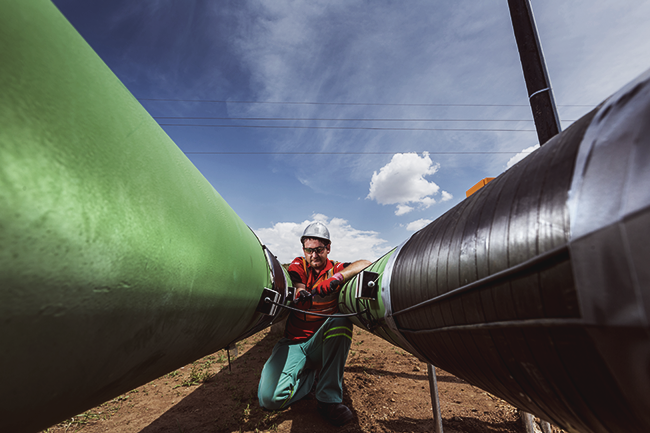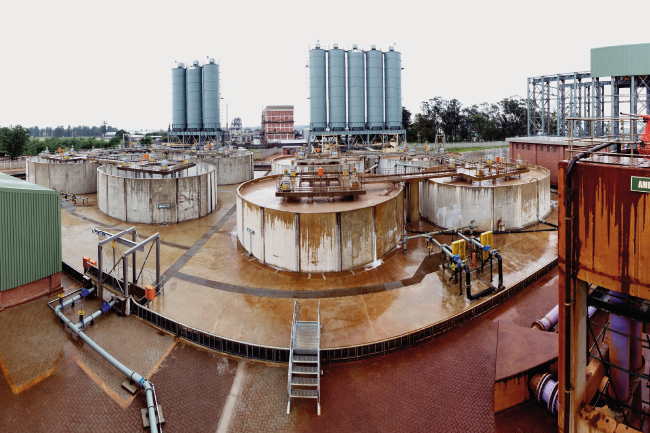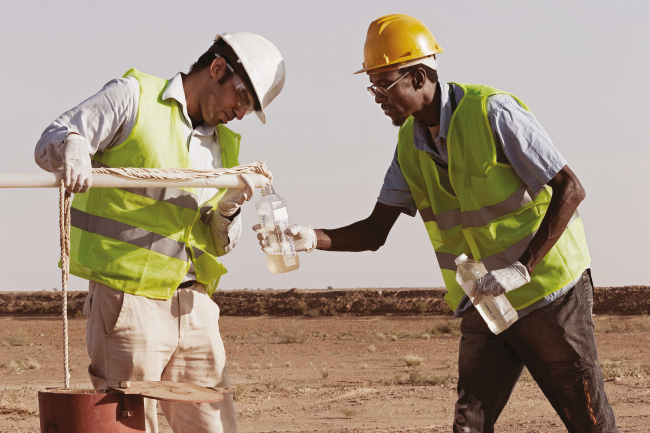An innovative water-saving technology that uses fibre-optic sensing to measure water flows at a South African platinum mine won an award for the Best Use of Smart Technology for Sustainability at the Mines and Technology conference in November last year. The event is Europe’s largest mining investment gathering, and it forms part of Mines and Money London, which is now in its 16th year. It attracts delegates from 75 countries, among them senior executives of 150 mining houses.
The winning water-wise technology was successfully trialled at Anglo American Platinum’s Mogalakwena platinum mine near Mokopane (formerly Potgietersrust) in Limpopo. The miner expects that this accurate, real-time monitoring of all mine-wide water flows will yield significant water savings. ‘Developed with our technology partners, Silixa, it is the world’s first permanent installation using this type of distributed sensing technology,’ states the company.
‘Unlike traditional sensors that measure at discreet, predetermined points, this installation uses a single fibre-optic circuit, several kilometres long – enabling continuous real-time metering of mine water flows across multiple points throughout a region comparable in size to Lower Manhattan.’

According to the UK-headquartered Silixa, its metering system can be installed ‘on-the-fly, without disrupting process flow or requiring costly calibration. The system is compatible with liquid, gas, slurry, organic, reagent and multiphase flows’.
The mining major’s plan to automate the water-balance system at Mogalakwena is supported by its other FutureSmart Mining technologies such as evaporation measurement. The group says that the system will not only conserve water but ultimately improve metal recovery. ‘Because it uses no expensive sensing parts and no power, it is both cost efficient and environmentally sound – an important step towards our sustainable mining goals.’
Typical of mining operations, Anglo American operates the majority of its mines (approximately 75%) in geographic regions with high water risks. As mines increasingly compete with industry, agriculture and local communities for the precious resource, water-related issues have risen to the top of the sustainable mining agenda. Without water, there can be no mining. It’s a vital ingredient in mineral processing, dust suppression, slurry transport as well as in the drinking and hygiene requirements of a large mining workforce.
Accurate measurements and real-time water data are crucial in understanding the water flow across any mining operation, which is a prerequisite to conserving water by improving water-balance calculations and efficiencies.
‘Mines use a water-balance model to establish losses and determine how much make-up water is required, mainly to replace the evaporation and seepage from tailings facilities and return water dams,’ says Peter Shepherd, principal hydrologist and partner at SRK Consulting Johannesburg – a specialist consultancy of engineers and scientists whose services include mining exploration, feasibility, mine planning, production and mine closure.
‘The biggest water loss in mining happens from tailings dams,’ he says. ‘On average 35% of water is lost through evaporation; 20% to 25% of the water remains locked in the tailings slurry; and, in older dams, 5% is lost through seepage from the bottom of the dam.’
However, South African miners have made good progress over the past decade as they comply with (and go beyond) ever-more stringent water-conservation regulations. They are not only reducing the water loss from tailings dams, but also increasing the amount of water that is retreated for use in process plants. According to Shepherd, South Africa’s platinum industry now captures between 50% and 60% of water from tailings dams for reuse in their operations.
‘In the past, these dams only had a limited clay layer or some other type of impermeable material as a barrier that still allowed seepage. The new tailings storage facilities are lined with an impermeable layer including plastics,’ he says. ‘That’s an expensive capital outlay but it’s being done worldwide, even in African countries such as the DRC and Ghana, especially in gold and some copper tailings dams.’
Shepherd believes that the next big drive to prevent water loss will focus on reducing evaporation from the dams. Millions of cubic metres of water could be saved annually by reducing the area where the slurry is deposited onto a tailings dam. Less exposure to the sun will reduce the evaporation loss, he says. This can be done by designing deeper tailings with a smaller footprint, or by covering the surface of return water dams. There are ingenious – but costly – solutions, such as plastic shade balls that flood the surface of pollution-control dams and block out the sunlight, and floating solar panels that generate energy while limiting evaporation.

Another method to reduce water in mining involves thickeners to produce drier tailings. Shepherd, who had recently returned from a site visit in Iran, said that South Africa could learn from the Middle East and neighbouring Namibia. ‘They’re in a similar situation because they have very little water. They use paste thickener, which is a robust technology that works like a filter press, where you squash the water out of the slurry so it ends up becoming a toothpaste-like consistency.
‘Paste thickening is not yet popular in South Africa, but I think it may gain in traction over the next 20 years, as the larger mining companies are striving to go “waterless”.’
The waterless mine – in other words a self-sufficient, closed loop in which mines collect, recycle and re-use run-off and groundwater without having to add significant fresh water from bulk suppliers – will free up potable water for local communities.
There are further spin-offs to reduced water consumption, including environmental and economic benefits. At Harmony Gold, a project to improve operational efficiency that began in May 2016 has significantly reduced water and electricity consumption, and also resulted in substantial cost savings.
Handré Groenewald, senior consultant at Pretoria-based engineering firm ETA Operations, which implemented the project, says: ‘Deep-level gold mines such as Harmony’s Kusasalethu operation – with a depth exceeding 3.5 km – make extensive use of water for cooling, drilling and cleaning. The used mine water needs to be pumped to higher mining levels or to the surface where it is reused and cooled. Reduced water consumption means less dewatering, resulting in reduced electricity consumption of the de-watering pumps.’
As part of the project, ETA improved the water-consumption monitoring system to highlight mining areas with excess use. It also reconfigured the cooling system and introduced a mobile device application to log water leaks. According to Groenewald: ‘The combined result of the three initiatives was that Kusasalethu’s water consumption reduced by an average of 5 megalitres per day.’
Harmony has also installed a water-treatment plant at Kusasalethu (near Carletonville in Gauteng), and another at Doornkop to convert mine water into drinking water. Two more are being built in Welkom to cut potable water use by 30%. The group intends to increase its volume of recycled water by 5% by end FY18. ‘We have exceeded this target with the volume of process water being recycled increasing by 12% in FY17 alone.’
Meanwhile, DRDGold is reusing acid mine drainage (AMD) water to extract gold from tailings. The company, which is planning a major surface-mining partnership with Sibanye-Stillwater, told Mining Weekly that it was receiving 8 megalitres of treated AMD water a day from state water organisation, TCTA (formerly known as Trans-Caledon Tunnel Authority). According to the article, DRDGold also receives about the same quantity of treated sewage water daily from the East Rand Water Care Company.
‘Not all mine-affected water is bad,’ says Vicki Shaw, founder of the Mine Water Co-ordinating Body [MWCB] – a public-private partnership that has grown out of the Strategic Water Partners Network and will be formally launched at this year’s Mining Indaba.
‘People think it’s the evil red stuff polluting our rivers. But there’s also the very slightly contaminated mine water that does not meet appropriate potable standards but could be used for other purposes.’
And here’s where the concept of ‘fit for purpose’ comes in. ‘It’s hugely exciting,’ says Shepherd. ‘In the past we treated all water to potable standard, but that’s really not necessary.’ The latest thinking is to use the lowest possible water quality required for each specific application within the mining process, thereby saving time, energy and cost while freeing up high-quality water for human consumption.
This will become even more important as South Africa’s water-scarcity increases, says Shaw. The MWCB proposes using mine-affected water to irrigate saline-resistant crops such as wheat and soya, and possibly for biofuel crops. As so often is the case, adversity creates new opportunities for those willing to think out of the box.
By Silke Colquhoun
Images: Gallo/Getty Images, Anglo American, DRDgold








